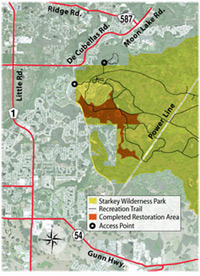 Left: The loader machine strips the branches off the tree, cuts it to length and loads it onto the semitrailer. Center: Trees being loaded onto the semitrailer. Right: Will VanGelder, District senior land management specialist, counts the rings on a harvested sand pine.
Left: The loader machine strips the branches off the tree, cuts it to length and loads it onto the semitrailer. Center: Trees being loaded onto the semitrailer. Right: Will VanGelder, District senior land management specialist, counts the rings on a harvested sand pine.
 Starkey restoration area in southwestern Pasco County.
Starkey restoration area in southwestern Pasco County.
The sound of chainsaws and heavy equipment ushered in the beginning of a three-year restoration project at the District’s J.B. Starkey Wilderness Park in Pasco County. The park is part of the Starkey Wilderness Preserve. The project’s goal is to restore 951 acres of uplands, including degraded scrub and sandhill communities.
Due to the lack of fire, sand pine has taken over much of the area. In addition to the pine trees, decades of vegetative debris has built up, leaving the area at risk for uncontrollable wildfires.
“In some areas of the preserve you can tell by the height of the trees that there hasn’t been a fire there for 60 to 70 years,” said Will VanGelder, District senior land management specialist. “If a fire were to get into this canopy, it would be hard to stop and the nearby neighborhoods would be in danger.”
One of the fastest-moving fires in state history, the Big Scrub fire, took place in the Ocala National Forest in 1935. The fire consumed about 35,000 acres of sand pine in four hours. VanGelder says if a similar fire broke out in the J.B. Starkey Wilderness Park, the area would burn in an hour or less.
In addition to being a fire hazard, the sand pines are also a hurricane risk because of the trees’ shallow root system. If Hurricane Charley had stayed on its projected path through Pasco County in 2004, all of the pine would have blown down, and it would not be eligible to be sold.
“It’s sad to see these old trees removed, but it needs to be done,” said VanGelder. “Fifty years is near the end of a healthy life cycle for sand pines.”
The J.B. Starkey Wilderness Park restoration project involves removing the sand pine canopy and vegetative debris through logging and other mechanical means. The District hired Lucas Border Trucking from Cross City, Florida, for the project.
The sale of the timber is being used to offset the cost of the restoration project. The company logs and sells the pine that is harvested. The larger logs are sold to make plywood and the rest are sold to make mulch.
The restoration project also involves the introduction of controlled burns to the area. Controlled burns are conducted to mimic natural fire cycles under a controlled situation. The object is to avoid uncontrolled wildfires and enhance the area’s natural conditions by maintaining the ecological and wildlife habitat values.
The result of these activities will allow sunlight to reach the forest floor, resulting in grasses and wildflowers returning to these areas. Grasses, wildflowers and acorns will provide a food base and improved habitat for the wildlife that would normally live in these upland areas.
Restoration efforts will allow the shrubby oaks and larger turkey oaks in the sandhills to become the dominant canopy again. These oak species currently exist in the preserve, but are repressed by the sand pines.
“In addition to reducing the fire hazard, this project will also restore the health of the habitats,” said VanGelder. “We would like to see scrub-jays and sandhill cranes return to the preserve.”
A variety of wildlife can be seen in the preserve, including gopher tortoises and gopher frogs, deer, snakes, Florida mice, and the occasional bald eagle.
The project will be conducted in phases over three years. All of the phases will occur south of the paved recreation trail, leaving the overwhelming majority of the park available for recreation. The first two phases will take place west of the power lines and the last phase will be east of the power lines. The first phase is nearing completion. Portions of the second phase have been completed to open trucking routes to the remaining timber in phase one.
The remote hiking trail west of the power lines, as well as the entire equestrian trail, will be temporarily closed as the restoration proceeds. Hiking will be rerouted to the paved trail and will connect to remote trails east of the power lines. Equestrian users will be directed to the entrance of the District’s Serenova Tract, which is also part of the Starkey Wilderness Preserve, until the project is complete. The entrance is located on State Road 52.
The District is also working with the Pasco County Parks & Recreation Department staff, who manage the park property, to ensure any inconvenience to park patrons is temporary and minimal. Park patrons will be able to learn more about the project and what areas are under restoration by viewing an information poster located at a kiosk near the park’s entrance.
For information about the recreation opportunities at the Starkey Wilderness Preserve, please contact the park at (727) 834-3247 or visit the District’s web site at WaterMatters.org/recreation/.
